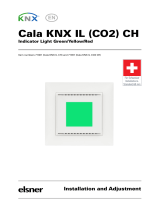
9 Transfer protocol
Sensor KNX T-UP basic • Software version 3.1 and higher
Status: 07.02.2023 • Technical changes and errors excepted.
183 OR logic 1: 8-bit output B Output 5,010 C R T
184 OR logic 1: Block Input 1,002 C W
185 OR logic 2: 1-bit switching output Output 1,002 C R T
186 OR logic 2: 8-bit output A Output 5,010 C R T
187 OR logic 2: 8-bit output B Output 5,010 C R T
188 OR logic 2: Block Input 1,002 C W
189 OR logic 3: 1-bit switching output Output 1,002 C R T
190 OR logic 3: 8-bit output A Output 5,010 C R T
191 OR logic 3: 8-bit output B Output 5,010 C R T
192 OR logic 3: Block Input 1,002 C W
193 OR logic 4: 1-bit switching output Output 1,002 C R T
194 OR logic 4: 8-bit output A Output 5,010 C R T
195 OR logic 4: 8-bit output B Output 5,010 C R T
196 OR logic 4: Block Input 1,002 C W
197 OR logic 5: 1-bit switching output Output 1,002 C R T
198 OR logic 5: 8-bit output A Output 5,010 C R T
199 OR logic 5: 8-bit output B Output 5,010 C R T
200 OR logic 5: Block Input 1,002 C W
201 OR logic 6: 1-bit switching output Output 1,002 C R T
202 OR logic 6: 8-bit output A Output 5,010 C R T
203 OR logic 6: 8-bit output B Output 5,010 C R T
204 OR logic 6: Block Input 1,002 C W
205 OR logic 7: 1-bit switching output Output 1,002 C R T
206 OR logic 7: 8-bit output A Output 5,010 C R T
207 OR logic 7: 8-bit output B Output 5,010 C R T
208 OR logic 7: Block Input 1,002 C W
209 OR logic 8: 1-bit switching output Output 1,002 C R T
210 OR logic 8: 8-bit output A Output 5,010 C R T
211 OR logic 8: 8-bit output B Output 5,010 C R T
212 OR logic 8: Block Input 1,002 C W
213 Logic input 1 Input 1,002 C W
214 Logic input 2 Input 1,002 C W
215 Logic input 3 Input 1,002 C W
216 Logic input 4 Input 1,002 C W
217 Logic input 5 Input 1,002 C W
218 Logic input 6 Input 1,002 C W
219 Logic input 7 Input 1,002 C W
220 Logic input 8 Input 1,002 C W
221 Logic input 9 Input 1,002 C W
No. Name Function DPT Flags



























